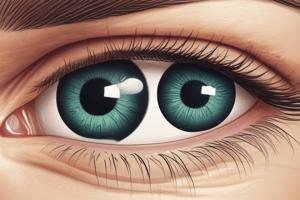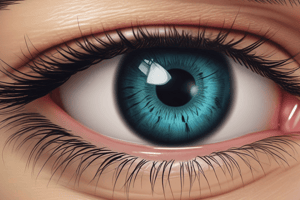Podcast
Questions and Answers
What is the purpose of the series suffix in the material classification code?
What is the purpose of the series suffix in the material classification code?
- To denote the surface modification of the material
- To indicate the group type of the material
- To indicate the revision level of the chemical formula (correct)
- To specify the Dk range of the material
Which prefix is used for soft lenses in the material classification?
Which prefix is used for soft lenses in the material classification?
- Filcon (correct)
- Focon
- RGP
- SCL
What Dk range would a group classified as 'V' indicate?
What Dk range would a group classified as 'V' indicate?
- Non-ionic materials with high water content
- Enhanced oxygen permeable materials (SiHy) (correct)
- Ionic materials with low water content
- Rigid gas permeable materials
For which country is the prefix optional in the material classification?
For which country is the prefix optional in the material classification?
Which of the following is NOT part of the 6-part code for material classification?
Which of the following is NOT part of the 6-part code for material classification?
What is the primary factor that affects oxygen permeability (Dk) in lens materials?
What is the primary factor that affects oxygen permeability (Dk) in lens materials?
Which of the following properties is NOT considered important for ideal lens materials?
Which of the following properties is NOT considered important for ideal lens materials?
How is the oxygen transmissibility (Dk/t) typically measured?
How is the oxygen transmissibility (Dk/t) typically measured?
Which of the following combinations correctly represents the contribution of D and k in oxygen permeability (Dk)?
Which of the following combinations correctly represents the contribution of D and k in oxygen permeability (Dk)?
The primary cause for lower corneal pH due to low oxygen transmissibility is mainly attributed to which factor?
The primary cause for lower corneal pH due to low oxygen transmissibility is mainly attributed to which factor?
Which condition is likely to result from low oxygen transmissibility in contact lenses?
Which condition is likely to result from low oxygen transmissibility in contact lenses?
Which of the following is an essential characteristic of durable lens materials?
Which of the following is an essential characteristic of durable lens materials?
Which manufacturing technique is NOT typically associated with ideal contact lens materials?
Which manufacturing technique is NOT typically associated with ideal contact lens materials?
What does a low contact angle indicate regarding wettability?
What does a low contact angle indicate regarding wettability?
Which method shows an advancing contact angle greater than a receding contact angle?
Which method shows an advancing contact angle greater than a receding contact angle?
Which technique produces a hydrophilic surface through bombardment with oxygen ions?
Which technique produces a hydrophilic surface through bombardment with oxygen ions?
What characteristic is common to all members of Group V-A in the proposed FDA classification for silicone hydrogels?
What characteristic is common to all members of Group V-A in the proposed FDA classification for silicone hydrogels?
Which group in the proposed FDA classification for silicone hydrogels includes both low and high-water content lenses?
Which group in the proposed FDA classification for silicone hydrogels includes both low and high-water content lenses?
What characterizes the captive bubble method in terms of contact angles?
What characterizes the captive bubble method in terms of contact angles?
Which of the following produces a contact lens material known for its hydrophilic characteristics?
Which of the following produces a contact lens material known for its hydrophilic characteristics?
What is the main reason ionic hydrogels attract tear proteins such as lysozyme?
What is the main reason ionic hydrogels attract tear proteins such as lysozyme?
What is the primary component of pHEMA that contributes to its hydrophilic behavior?
What is the primary component of pHEMA that contributes to its hydrophilic behavior?
In the Dk range classification system, what does a Dk value of 3 represent?
In the Dk range classification system, what does a Dk value of 3 represent?
How are the numerical Dk codes expressed in terms of oxygen permeability?
How are the numerical Dk codes expressed in terms of oxygen permeability?
When evaluating wettability in vivo, which of the following metrics is used?
When evaluating wettability in vivo, which of the following metrics is used?
What effect does surface treatment have on non-ionic hydrogels?
What effect does surface treatment have on non-ionic hydrogels?
What is the typical water content of contact lenses made from pHEMA when fully hydrated?
What is the typical water content of contact lenses made from pHEMA when fully hydrated?
Which group is specifically identified for low water content, non-ionic, non-surface treated hydrogels?
Which group is specifically identified for low water content, non-ionic, non-surface treated hydrogels?
What is the primary concern of the Dk range in contact lens wear?
What is the primary concern of the Dk range in contact lens wear?
Which factor does NOT influence O2 permeability?
Which factor does NOT influence O2 permeability?
What is a disadvantage of low water content hydrogels?
What is a disadvantage of low water content hydrogels?
Which characteristic is associated with high water content hydrogels?
Which characteristic is associated with high water content hydrogels?
Which of the following is NOT an advantage of low water content hydrogels?
Which of the following is NOT an advantage of low water content hydrogels?
What is a disadvantage of high water content hydrogels in terms of manufacturing?
What is a disadvantage of high water content hydrogels in terms of manufacturing?
How does temperature affect O2 permeability?
How does temperature affect O2 permeability?
Which disadvantage is NOT related to high water content hydrogels?
Which disadvantage is NOT related to high water content hydrogels?
Which of the following best describes the effect of chemistry of the polymer on O2 permeability?
Which of the following best describes the effect of chemistry of the polymer on O2 permeability?
What is a notable disadvantage of fluorosilicone acrylates when they are manufactured too thin?
What is a notable disadvantage of fluorosilicone acrylates when they are manufactured too thin?
Which property is essential for SCL materials to ensure proper movement during wear?
Which property is essential for SCL materials to ensure proper movement during wear?
What primary benefit does the addition of fluorine provide in fluorosilicone acrylates?
What primary benefit does the addition of fluorine provide in fluorosilicone acrylates?
Which disadvantage is associated with cellulose acetate butyrate (CAB)?
Which disadvantage is associated with cellulose acetate butyrate (CAB)?
In terms of SCL optical quality, which aspect does NOT play a crucial role?
In terms of SCL optical quality, which aspect does NOT play a crucial role?
What is a common disadvantage of silicone acrylates (siloxanes)?
What is a common disadvantage of silicone acrylates (siloxanes)?
Which property is NOT part of the important physical/chemical properties of SCL materials?
Which property is NOT part of the important physical/chemical properties of SCL materials?
What aspect is particularly affected by the dimensional stability in fluorosilicone acrylates?
What aspect is particularly affected by the dimensional stability in fluorosilicone acrylates?
What is a key characteristic of silicone acrylates in terms of design choices?
What is a key characteristic of silicone acrylates in terms of design choices?
Which of the following is a listed disadvantage for some materials in silicone acrylates?
Which of the following is a listed disadvantage for some materials in silicone acrylates?
Flashcards
What is the prefix used for in material classification?
What is the prefix used for in material classification?
A prefix is used in the material classification code, but it's only required for materials outside the USA.
What does 'filcon' and 'focon' indicate in the material classification code?
What does 'filcon' and 'focon' indicate in the material classification code?
The stem of the material classification code indicates the type of lens material. Filcon is used for hydrogel soft lenses, while Focon represents rigid gas permeable lenses.
What does the series suffix in the material classification code indicate ?
What does the series suffix in the material classification code indicate ?
The series suffix in the material classification code represents the revision level of the chemical formula. It's indicated by a capital letter (A, B, C,...) that follows the stem.
What information does the group suffix for soft lens materials (SCL) provide?
What information does the group suffix for soft lens materials (SCL) provide?
Signup and view all the flashcards
What does the group suffix in the material classification code represent for rigid gas permeable lenses (RGP)?
What does the group suffix in the material classification code represent for rigid gas permeable lenses (RGP)?
Signup and view all the flashcards
Oxygen Permeability (Dk)
Oxygen Permeability (Dk)
Signup and view all the flashcards
Oxygen Transmissibility (Dk/t)
Oxygen Transmissibility (Dk/t)
Signup and view all the flashcards
Epithelial Microcysts
Epithelial Microcysts
Signup and view all the flashcards
Endothelial Polymegethism
Endothelial Polymegethism
Signup and view all the flashcards
Wettability
Wettability
Signup and view all the flashcards
Contact Angle
Contact Angle
Signup and view all the flashcards
Corneal pH Decrease
Corneal pH Decrease
Signup and view all the flashcards
Corneal Edema
Corneal Edema
Signup and view all the flashcards
Plasma Treatment
Plasma Treatment
Signup and view all the flashcards
Endothelial Blebs
Endothelial Blebs
Signup and view all the flashcards
Graft Polymerisation
Graft Polymerisation
Signup and view all the flashcards
PMMA
PMMA
Signup and view all the flashcards
Endothelial Mosaic
Endothelial Mosaic
Signup and view all the flashcards
pHEMA
pHEMA
Signup and view all the flashcards
Tear Break-Up Time (BUT)
Tear Break-Up Time (BUT)
Signup and view all the flashcards
Sessile Drop Method
Sessile Drop Method
Signup and view all the flashcards
Silicone Hydrogel Contact Lens (SiHy CL) FDA Groups
Silicone Hydrogel Contact Lens (SiHy CL) FDA Groups
Signup and view all the flashcards
SiHy CL FDA Group V-A
SiHy CL FDA Group V-A
Signup and view all the flashcards
SiHy CL FDA Group V-B1
SiHy CL FDA Group V-B1
Signup and view all the flashcards
SiHy CL FDA Group V-B2
SiHy CL FDA Group V-B2
Signup and view all the flashcards
SiHy CL FDA Group V-C
SiHy CL FDA Group V-C
Signup and view all the flashcards
SiHy CL FDA Group V-D
SiHy CL FDA Group V-D
Signup and view all the flashcards
Dk Range (Oxygen Permeability)
Dk Range (Oxygen Permeability)
Signup and view all the flashcards
Material Classification System
Material Classification System
Signup and view all the flashcards
Thermoplastic
Thermoplastic
Signup and view all the flashcards
Silicone Acrylates (SA)
Silicone Acrylates (SA)
Signup and view all the flashcards
Fluorosilicone Acrylates (FA)
Fluorosilicone Acrylates (FA)
Signup and view all the flashcards
Cellulose Acetate Butyrate (CAB)
Cellulose Acetate Butyrate (CAB)
Signup and view all the flashcards
Water Content
Water Content
Signup and view all the flashcards
Elasticity
Elasticity
Signup and view all the flashcards
Dimensional Stability
Dimensional Stability
Signup and view all the flashcards
Deposit Resistance
Deposit Resistance
Signup and view all the flashcards
Lens Flexure
Lens Flexure
Signup and view all the flashcards
Water Retention
Water Retention
Signup and view all the flashcards
Temperature Sensitivity
Temperature Sensitivity
Signup and view all the flashcards
Material Chemistry
Material Chemistry
Signup and view all the flashcards
Tonicity
Tonicity
Signup and view all the flashcards
Low Water Content Hydrogels
Low Water Content Hydrogels
Signup and view all the flashcards
High Water Content Hydrogels
High Water Content Hydrogels
Signup and view all the flashcards
Study Notes
Contact Lens Material
- Contact lens materials must meet various criteria
- Ideal lens materials meet corneal oxygen requirements
- They are inert, resist spoilage, and are dimensionally stable
- They need high optical clarity and high quality surfaces
- Minimal patient care required and easy machinability/latheability/moldability
Learning Outcomes
- Understand ideal lens properties
- Evaluate material properties
- Recognize the role of oxygen permeability (Dk)
- Analyze wettability
- Distinguish between material types
- Understand material classification codes
- Assess manufacturing techniques
Important CL Material Properties
- Oxygen permeability
- Wettability
- Scratch resistance
- Rigidity (GP CLs)
- Good stability
- Deposit resistance
- Durability
- Flexibility (SCLs)
Oxygen Permeability (Dk)
- D: the speed of oxygen molecules passing through a material (diffusion).
- k: the amount of dissolved oxygen molecules in the material (solubility).
- Measured in FATT units or BARRERS, 10⁻¹¹ cm²/s ml O₂ /ml mmHg.
- Measured in ISO units, 10⁻¹¹ cm²/s ml O₂ /ml hPa
- Multiplying traditional Dk values by 0.75 converts to ISO units.
- Impacted by temperature and pressure.
Impact of Low O₂ Transmissibility
- Epithelial microcysts
- Endothelial polymegethism
- Lower corneal pH due to CO₂ retention
- Oedema
- Endothelial blebs due to hypoxia (low oxygen)
CL Wettability
- Ability of a liquid drop to adhere to a solid surface
- Measured by contact angles.
- Low contact angle means good wettability.
- Different measurement methods yield different results
- Enhanced by surface treatment (plasma treatment, bombarding with oxygen ions, or graft polymerisation)
CL Wettability Measurement Techniques
- In vitro:
- Sessile drop
- Wilhelmy plate
- Captive bubble
- In vivo
- Tear break-up time (BUT or TBUT)
- Drying time
Material Properties
- Oxygen permeability (Dk): property of a material
- Oxygen transmissibility (Dk/t): property of a lens (often at −3.00DS)
Contact Lens Materials
- PMMA (Poly(methyl methacrylate))
- HEMA (Hydroxy ethyl methacrylate)
- polyHEMA
- PHEMA (2-hydroxyethyl methacrylate)
Contact Lens Classification
-
Classified by a 6-part code:
- Prefix
- Stem
- Series suffix
- Group suffix
- Dk range
- Surface modification code
-
Dk range (oxygen permeability): numerical code indicating permeability in ranges considered significant in contact lens wear
-
Modification code (lower-case "m"): Surface of the lens is modified, differing chemically from the bulk material.
Examples of Contact Lens Material
-
Paflufocon B III 3
- Rigid lens (paflu - USAN prefix)
- 2nd formulation (B - USAN series suffix)
- Contains both silicone and fluorine (III - Group suffix)
- Dk range 31-60 ISO units
-
Etafilcon A IV 1
- Contains >10% water by mass (Eta - USAN prefix; A - USAN series suffix)
- Material is ionic (IV - Group suffix)
- Dk range 1–15 ISO units
Common RGP Materials
- Cellulose acetate butyrate (CAB)
- Advantages: good wettability, relatively inert, does not attract protein
- Disadvantages: Low Dk, sometimes requires moulding, limited designs, scratches easily.
- Silicone acrylates (SA)
- Advantages: wide range of materials, designs, good dimensional stability, practitioner control, good vision
- Disadvantages: can attract protein from tears, some materials are brittle, 3&9 o'clock staining.
- Fluorosilicone acrylates (FA)
- Advantages: very high Dk values, suited for flexible extended-wear, better wettability, fewer deposit problems, suitable for modifications.
- Disadvantages: may be brittle; less stability; manufacture dependent; corneal adhesion
SCL Manufacturing Techniques
- Molding (anhydrous raw materials - xerogel)
- Lathing (xerogel)
- Spin-casting
- Combinations of these methods
- Molding; stabilized soft
SCL Materials: Physical Compatibility
- Must allow contact lens movement
- Must be flexible, even in thicker contact lenses
SCL Materials: Optical Quality
- Depends on surface quality after hydration
- Shape regularity after hydration
- BVP (base curve value) within tolerance
- No unwanted toricity
- Accurate cylinder axis if toric (astigmatism)
Important Physical/Chemical Properties of SCL
- Oxygen permeability
- Water content
- Elasticity
- lonicity
- Deposit resistance
- Refractive index
- Durability
- Environment susceptibility
Influential Factors of O₂ Permeability
- Water content
- Polymer chemistry
- Methods of water retention
- Temperature
- pH
- Tonicity
H₂O Content Influences
- Oxygen permeability
- Refractive index
- Rigidity
- Durability
- Minimum thickness to prevent pervaporation
- Environmental susceptibility
- Contact lens care system choice
Hydrogels: Low Water Content
- Advantages: less susceptible to environmental influences, more stable, higher rigidity, easier to handle, better refractive index, easier manufacture, higher reproducibility, better wettability, less likely pervaporation staining.
- Disadvantages: Lower Dk; less flexible; thin contact lenses are more difficult to handle.
Hydrogels: High Water Content
- Advantages: Higher Dk; More flexible; Faster restoration of shape after deformation.
- Disadvantages: Fragile; more susceptible to environmental factors; more likely deposition; lower refractive index; less stable parameters; less reproducibility; thermal disinfection not recommended; more difficult to manufacture; larger tolerances often necessary
- Cannot be made too thin
Physical Properties - Elasticity
- Large elastic limit (large range before breaking)
- Strong material (high Young's modulus)
- Combination of above leads to durable contact lenses
- Rapid shape recovery
Modulus in soft CL materials
- Numerical (Young's modulus) values for different materials. (PMMA is high; PHEMA is low).
Ionicity
- Hydraulic and ionic permeability necessary for adequate lens movement, allows post-tear film to reform
- Pore size determines substances penetrating the hydrogel; lactate accumulates
- Lysozyme, fluorescein can penetrate high-water content lenses, Na+ permeability important
Refractive Index
- Monomer composition determines the ideal refractive index
- In hydrogels, there is a near-linear link between water content and refractive index
- Clinically and experimentally, this correlation is used to assess water content
Susceptibility
- Dimensional stability changes with lens environment
- Increasing temperature increases water absorption leading to opaqueness.
- pH changes alter lens properties
- Tonicity (salinity) affects water content in the lens
Studying That Suits You
Use AI to generate personalized quizzes and flashcards to suit your learning preferences.




